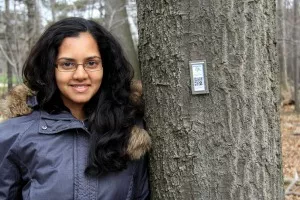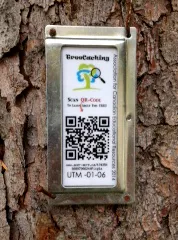
UTM "tree caching" trail leads graduate to employment
If you go into the woods today, you’ll probably notice some shiny new tags on trees around the U of T Mississauga campus. The business card-sized metal frames contain a laminated card with a QR code. Scan that code with an app on your smartphone, and you’ll be taken to a web page packed with info about the tree, including a photo, identifying characteristics and more.
Known as a “tree caching” trail, the tags are the work of Nimesha Basnayaka, a recent graduate of the environmental science and geography program at UTM. Basnayaka created and implemented a self-guided tour of the campus’ trees as part of a recently wrapped year-long experiential learning internship with Climate’s Sake, an environmental education charity based in Mississauga.
Over the past school year, Basnayaka worked with the UTM grounds division to identify and catalogue significant tree specimens. Fifty-four trees were initially identified, with 24 trees making the final list.
“We tried to get as many species as possible to get an accurate representation of the species that are found on campus,” Basnayaka says. Follow the trail and you’ll find red and white oaks, several varieties of maple trees and a northern catalpa located near Deerfield Hall.
According to Basnayaka, it was also important to include trees that are significant to the campus’ history. “We included a white oak, located between IB and CCT, that’s over a hundred years old, as well as the crabapple trees between Davis and Kaneff.”

The UTM trail is the latest project for Climate’s Sake. Over the past three years, it has established trails in the Riverwood Conservancy, the Humber Arborteum, Erindale Park and Stamford Collegiate Institute.
Basnayaka loves the intersection of nature and technology. “We don’t always take time to notice what’s around us,” she says. “The tree caching tags can help draw attention to that, and help us appreciate the natural world.”
Her internship landed the recent graduate a full-time job with Climate’s Sake. Basnayaka says she learned a lot about tree species and also how to put her academic skills to practical work. Now an employee, Basnayaka will implement the “Planting for Change” program, working with schools across Ontario to plant trees and shrubs and measure the effects of climate change in the province.
